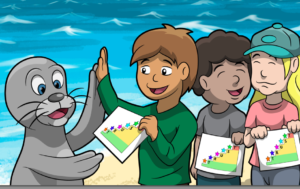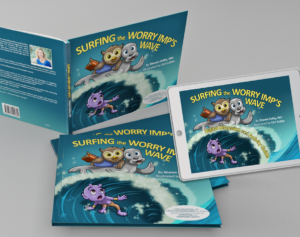
When To Reward or Not To Reward?
Last week, I discussed when and how to push your child a little out of their comfort zone. (Read last week’s article: When to Push Your Child).
For some children, depending on the task, you’ll be able to give them a little push without a reward, which is the preferable situation, but sometimes trying to tap into intrinsic motivation just doesn’t work. What to do instead? When to reward?
Work – Play – Work – Play
Remember when our children were babies? Often times, to be able to get our child to eat the vegetable baby food such as peas, we needed to follow it with something more delicious like apples and blueberries. As you probably realize, we continue to do this throughout our lives.
I remember being a university student, studying for exams. My friends and I would go to the university library to study, and set times that we would meet each other and take breaks or maybe grab a snack, coffee or tea. We would set up our schedule for the whole day like this. We were building our own motivation system. We weren’t being externally controlled by anybody but we realized it was hard to study for exams all day. We wanted to get good marks and also have a bit of enjoyment through social time in seeing each other, as well as grabbing a snack.
We can teach this to our children, by teaching them about this principle of work – play – work – play.
Examples of Rewards for Non-Preferred Activities Followed by Preferred Activities
- Getting a vaccination at the doctors followed by a nice lunch out together at a favourite restaurant
- Homework followed by a predetermined amount of screen time
- Getting a cavity filled by the dentist followed by an outing or a trip to the bookstore
- Chores followed by a family outing which you could plan at your weekly family meeting
- Going to a new activity which can create anxiety for some kids and therefore be non-preferred, followed by a hot chocolate
Caution about Associated Rewards
Careful not to phrase your offer as a bribe.
You’re not going to say or imply: I want to reward you and so if you do this then you will do this.
You are going to validate your children and let them know that you understand that they’re really scared and you understand the reason. You understand that they feel uncomfortable about getting the needle and you don’t like it when that happens either, but you do know this is something that they will be able to manage and get through so you’d like to plan something fun that could be done together after the appointment.
You could say something like: “Let’s think of a fun idea so that when you’re at the doctors, you can just try and take your mind off getting the shot and just think about having lunch at our favourite restaurant.”
This is very different than saying “If you go to the doctors, I’ll take you out to your favourite lunch”. When you start the sentence with “IF…”, it sounds very externally controlling and many kids, especially the highly-sensitive ones, will push-back against this.
The main point is to express the offer as a non-preferred activity followed by preferred activity and have your children see that you are on their side – you’re with them.
You’re not pushing them into the corner, although you are saying it has to be done. You try to show them… I’m on your side, I understand this and I’ve got your back. I completely understand why you don’t want to go to the doctors but I’m trying to make this be the best it can be.
What Is the Minimal Sufficiency Principle?
In the wonderful book Redirect, Timothy Wilson explains that “When there is zero motivation to begin with, there’s just no intrinsic motivation”. At this point, it’s okay to use rewards, it’s just how it’s done and knowing when to reward.
If there’s zero motivation, we want to use rewards but downplay their power and significance.
This is called “The Minimal Sufficiency Principle” which means that the rewards are not so strong that they are viewed as the reason for doing something.
In Redirect, Timothy Wilson talks about an experiment that was conducted in Canada with some four year olds:
Some pre-schoolers were introduced to a drum. The first group were shown toys and there was a drum in the room, but there was nothing specifically associated with the drum or said about the drum – it was just one of the toys that they could play with.
For another group, they were told that if they played with the drum, then underneath a box was a hidden prize – a hidden reward that they would get just because they played with the drum.
The third group had a combined intervention. The researcher mentioned that there was a drum and if they chose to play with it, there would be something nice for them later on. The reward was mentioned but minimized.
Through the research, they found that naturally the group that was told that there was a prize or reward underneath the box played with the drum the most, but then once they got the reward, they never went back to the drum.
The children who were introduced to the drum and told that if they did play with it, they would receive something nice to go along with it later, also played with the drum a lot, but even when they got their little reward later, they continued to play with the drum in subsequent sessions.
This is the idea of “The Minimal Sufficiency Principle”. The reward is not directly made to be extremely obvious. The goal is to just do something to nudge your child along enough, to get him/her interested and then hopefully the motivation will become intrinsic.
When I’m working with children to face their fears, I often have them keep track of their data. This can be done on a print-out of a blank calendar or on a drawing of a staircase (see the image in last week’s post). Sometimes just keeping track of one’s own data and giving oneself a star sticker, a “happy face”, or a check mark for each time their goal is accomplished, is enough to build in motivation to keep going.
If not, then I’ll discuss the idea of building in a reward with the parents, through one of the two methods mentioned above.
I hope this helps you figure out when to reward,
Warmly,

PS. Registration is now open for my next round of Self-Empowerment groups for 7-9 year olds and 10-12 year olds. To find out more information and to register online click here and scroll down.
PPS. The last day to preorder my new children’s book on anxiety: Surfing the Worry Imp’s Wave is this Wednesday, January 31st, 2018. Up until midnight on Jan. 31st, you can preorder my book and the free accompanying Digital Discussion and Activity Guide, at the special introductory price of $25 by clicking here.

Want to Connect?
Subscribe now to receive free weekly parenting tips and inspiration.






